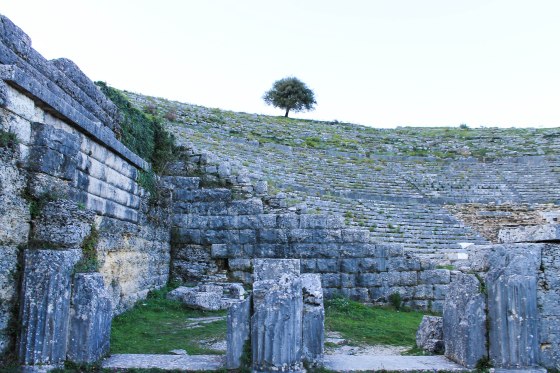We arrived in Metsovo in the early afternoon on Friday, and as we stepped off of the bus we noticed something unusual: the smell of a wood-burning fire, yellow-tinged leaves on the trees, and a distinct chill in the air. Those of us from the Midwest immediately broke into huge smiles, not realizing how much we had missed fall back home. Not that Metsovo is entirely similar to my home in Ohio–in fact, Metsovo was entirely different from what I expected and unlike any other place I’ve ever been.
We started out by talking a little bit about the unique history of the town and learned that many residents still speak Vlach, an unwritten language completely unrelated to Greek, and consider themselves to be Vlach as well as Greek due to their isolated location and strong cultural heritage. The combination of this culture plus the geography made arriving in Metsovo quite the surprise.
One of our first stops was the church in Metsovo. This region is known for wood carving and icons painted in the Cretan style, that is with olive oil mixed into the paint. The colors are absolutely stunning and brighter than the typical orthodox church.
We also visited a folk art museum, which was a restored home of an aristocrat. Again, the interior was completely unexpected: the thick walls and cozy tapestries made me feel like I was visiting somewhere much further north, as opposed to the Greece we typically consider to be warm and Mediterranean. While the fireplaces weren’t lit and there was no food cooking on the stove, I can only imagine how snug families who lived in this house must have been in their furs and large communal beds.

Before dinner, some friends and I wandered into a small park on a hill and saw a stunning sunset overlooking the valley. The weather got even chillier right away, and we hurried to a taverna our professors had recommended. The choices were limited: the taverna offered 2 types of meat (sausage and souvlaki), 2 types of cheese (feta and a traditional smoked cheese called Metsovone), bread and red wine. Naturally, we ordered everything and the owner brought out the fresh food on wax paper. We devoured it and then sleepily wandered back to our hotel to enjoy some hot chocolate and Greek delight next to the fire.

On Saturday we took a trip to the college town of Ioannina. Ioannina is on a lake and, like Metsovo, has a unique history. During each period in Greek history, Ioannina has been able to absorb new cultural ideas and populations while also maintaining a surprising degree of autonomy. As a result, it has seen Muslims, Jews and Christians living together in peace throughout most of its history. It’s easy to see why–this town is so peaceful I couldn’t imagine any conflict ruining its tranquility. At the same time, it has known its fair share of notorious characters, including the infamous Ali Pasha, who was known for beheadings and throwing dissenters off of cliffs, but also modernizing the town. He was killed in a monastery on the island in the center of the lake by a single bullet, which can still be seen at the monastery today.

To round out the day, we stopped by the temple and theater of Dodona, the largest theater in Ancient Greece and the second most important oracle. Although it has been destroyed and rebuilt many times (and is in the process of being restored now), this temple has been in use since neolithic times. At its peak, the theater could seat 18,000 people. I shivered a little bit when I stood at the center and thought about how thousands of years’ worth of people came here for advice and entertainment.

Finally, on Sunday, we visited Meteora. Meteora literally means “suspended in midair” and it’s easy to see why. Monks and nuns have considered Meteora a holy space for hundreds of years, and although it is now a major tourist destination, the monasteries and nunneries still feel as though they are floating in an alien landscape, far removed from anything familiar. We visited two monasteries (Megalo Meteoro and Varlaam) as well as a nunnery (Roussanou). While each was stunning in its own respect, I particularly enjoyed the nunnery. I found the monasteries to be a bit more impersonal because the monks hide themselves away to avoid tourists. The nunnery was far less crowded, although it was smaller than the monasteries, and the nuns seemed to be happy to see us. They showed us the traditional food, drinks, and crafts they make at the nunnery and were happy to answer our questions, although their English was limited. Even though I’m not religious, I felt much more of a connection with Roussanou than I had at either of the monasteries. It was secluded (it was quite the hike to reach the nunnery from the road!) and quiet and much easier to reflect on our beautiful surroundings. I spent a few minutes by myself on a small balcony with this view and could have stayed there all day.




Great shots =)
LikeLike
You post interesting articles here. Your page deserves
much more visitors. It can go viral if you give it
initial boost, i know useful tool that can help you, simply
search in google: svetsern traffic tips
LikeLike